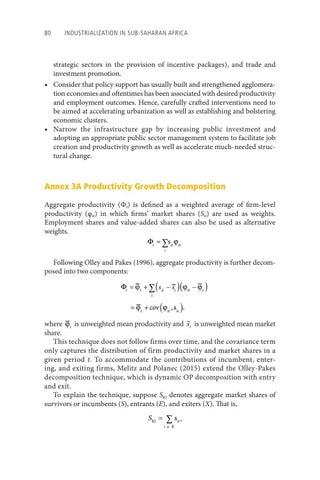80 Industrialization in Sub-Saharan Africa
strategic sectors in the provision of incentive packages), and trade and investment promotion. • Consider that policy support has usually built and strengthened agglomeration economies and oftentimes has been associated with desired productivity and employment outcomes. Hence, carefully crafted interventions need to be aimed at accelerating urbanization as well as establishing and bolstering economic clusters. • Narrow the infrastructure gap by increasing public investment and adopting an appropriate public sector management system to facilitate job creation and productivity growth as well as accelerate much-needed structural change.
Annex 3A Productivity Growth Decomposition Aggregate productivity (Φt) is defined as a weighted average of firm-level productivity (φit) in which firms’ market shares (Sit) are used as weights. Employment shares and value-added shares can also be used as alternative weights. Φt = ∑sit ϕit i
Following Olley and Pakes (1996), aggregate productivity is further decomposed into two components:
(
)(
Φt = ϕt + ∑ s it – st ϕit – ϕt i
)
)
= ϕt + cov ( ϕit , sit , where ϕ t is unweighted mean productivity and st is unweighted mean market share. This technique does not follow firms over time, and the covariance term only captures the distribution of firm productivity and market shares in a given period t. To accommodate the contributions of incumbent, entering, and exiting firms, Melitz and Polanec (2015) extend the Olley-Pakes decomposition technique, which is dynamic OP decomposition with entry and exit. To explain the technique, suppose SKt denotes aggregate market shares of survivors or incumbents (S), entrants (E), and exiters (X). That is, SKt =
∑s ,
i ∈ K
it

